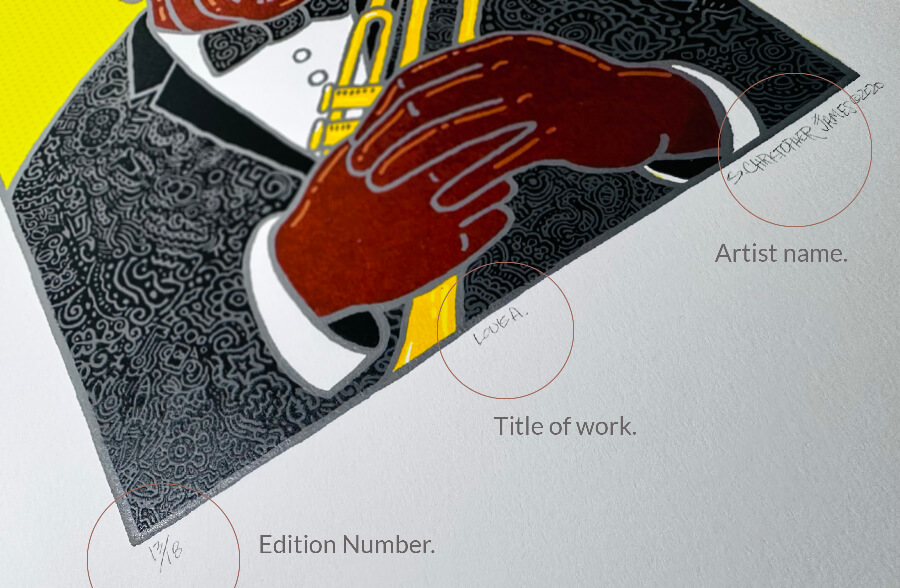Art Traveler
The reason behind the editioning of prints
The printmaker’s editioning of a print is an indicator of the uniqueness of the art print. Uniqueness meaning that each hand-pulled print will be different because humans, unlike machines, are not perfect. We move the paper slightly off-center, apply varying degrees of pressure or place the ink down unevenly. Therefore, each print can be unlike the other in many ways. Editioning is an added step to document that uniqueness.
The labeling is done in numerical values, indicating the number of prints for the particular artwork. There are also certain marks that printmakers use on their works as a way to note the way it was produced. I will list some of those in this article.
Printmaking, specifically screen printing, has always been a joy working with as an art form. It’s hands-on, down, and dirty, with results that make every edition slightly different than the other. This, in turn, leads to some interesting variations. For example, I use a one-color press and usually do multiple colors. The challenges of doing it this way are many, but the results can be pretty interesting.
One of the traditional ways to keep track of multiple prints that are finite or limited in quantity is to number them along with the artist’s signature. For instance, if the artist prints 18, each print will be assigned a number from 1 to 18. In this photo example, the print number is 13. Therefore, it would be labeled 13/18, meaning it was print number 13 of the limited edition of 18. The artist hand-pulled no more than 18 in this limited edition run. Ideally, the artist will create no other prints beyond 18. Minimizing the print quantity gives the print provenance and value. The fewer the number of hand-pulled prints, the more value it has.

Using a sharp pencil to label your prints is best, as ink labels are relatively easier to reproduce. In addition, using a pencil will help to avoid fraudulent reproduction.
Some artists may print as many as demand allows. These are called open editions. Even when a print run is over, the artist still has the option to reprint. Open editions are popular with concerts, bands, fairs, and other events and are considered collectible items for some. These may be signed but usually not numbered, as the runs could be unlimited.
Printmakers use other notations beyond just the simple numbering of the editions. I will list some of the more prominent inscriptions, but depending on the artist, there could be more.
- A/P (Artist’s Proof) – This is when the artist pulls several prints out with their edition for personal use. These are printed simultaneously with the rest of the edition and can be up to 10% of the print run.
- B.A.T. (Bon a Tirer) – The first perfect print to be pulled from the matrix is signed as the B.A.T. (good to pull). The edition and artist’s proofs are then matched up to this as it is printed. The B.A.T. usually remains the property of the editioning atelier.
- T/P (Trial proof) – These prints are pulled to assess the development of an image. They are marked as trial proofs as they indicate the unfinished progress of a print. They can be worth large sums if they land on the market as they show an insight into the artist’s working methods.
- S/P ( State Proof) – This general term covers all working proofs. It can refer more specifically to trial proofs being reworked after an image has been editioned.
- V/E (Variable Edition) – These labels all refer to the print being unique or containing unique elements that cannot be exactly reproduced in another pulling. This label is best replaced by the simple convention 1/1 (edition of 1).
- Imp. – From the Latin “impressit” which means “has printed.” An artist who has printed their work may write this after their signature.
- H.M.P, H.P.M, or H.M.M. (Hand Modified Print, Hand Painted Print, or Hand Modified Multiple) – Sometimes artists add features to a print by hand after the edition is created. These are most commonly found in serigraph prints.
If applicable, I will generally place most of these notations on the back of the print to keep writing on the print side to a minimum. Please see the links below for a more comprehensive look at the type of notations printmakers use and other information on print editions.
Artwork Archive
https://www.artworkarchive.com/blog/9-things-to-know-about-art-editions
Artsy
https://www.artsy.net/article/hang-up-gallery-a-guide-understanding-print-editions-techniques-ap-hc
Print Gonzales
https://www.printgonzalez.com/hellbox/2018/4/3/printmaking-101-series-a-guide-editioning-and-signing-fine-art-prints
- 1
- 2

